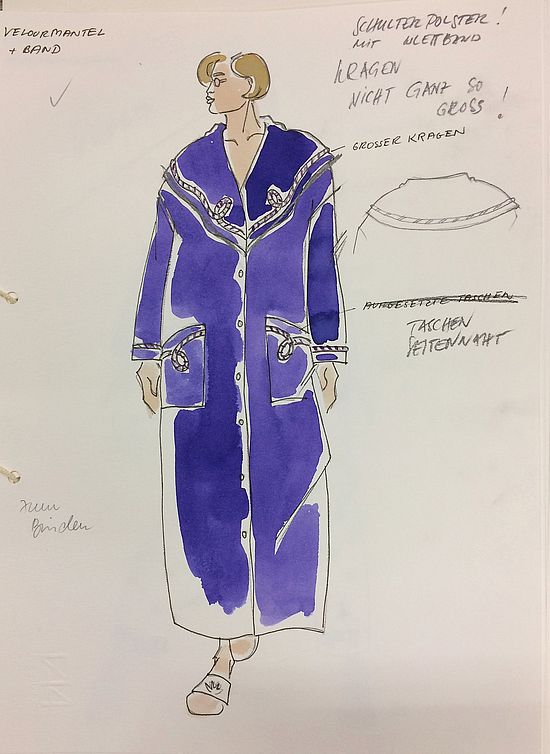
Contact
Project relevant publications and presentations
Publications
"In the Light of History: Bedside Lamp No. 702 and its Authorship," in Rehm, Robin, and Christoph Wagner (eds.): Design-Patente der Moderne. 1840-1960, Berlin: Gebr. Mann 2019, pp. 324-329.
"Stereo Imaging In Fashion Photography: How Hollywood (May Have) Inspired a Swiss Knitting Company in the 1950s,"Networking Knowledge: Journal of the MeCCSA Postgraduate Network 11/1 (2018), pp. 38-55.
"Review of: Rainer Wenrich (ed.), "The Mediality of Fashion. Clothing as Cultural Practice,"Journal of Folklore 113/2 (2017), pp. 307-308.
"Design Documentation, Knitting Patterns, and Underwear. Textiles Entwerfen in der Industrie am Beispiel der Hanro-Sammlung," in Link, Sarah Elena, and Cornelia Weber (eds.): Materielle Kultur in universitären und außeruniversitären Sammlungen, vol. 1, Junges Forum für Sammlungs- und Objektforschung. Contributions to the Workshop of the Coordination Office for Academic University Collections in Germany; Berlin, September 29-October 1, 2016, Humboldt University of Berlin, Humboldt University of Berlin Publication Server 2017, pp. 102-106, https://edoc.hu-berlin.de/handle/18452/19221.
"Analog Music Furniture and Digital Surrogates. Notes on the Materiality and Design of Music Media in the Residential Environment," in Bartz, Christina et al. (Eds.): Enclosures. Mediale Einkapselungen, Paderborn: Wilhelm Fink 2017, pp. 71-90.
Papers
"Designarchaeology of Mass-Produced Articles in the Apparel Industry: The Example of HANRO." 8th Research Camp Studying (In) Museums of Applied Arts, University of Bern, December 2018.
"Between Quality and Boredom. The Mediating Function of Standards." Workshop at the Annual Conference of the Society for Media Studies, University of Siegen (together with Felix Gerloff and Moritz Greiner-Petter), September 2018.
"Hanro. From Industrial To Cultural Asset. Potentials and Prospective For a Corporate Archive Entering Museum Collections." Fashion and Clothing in EuropeanMuseums conference, Strasbourg (with Saskia Klaassen and Laura Hompesch), May 2018.
"'pi, pa & po': experimentation and the fading of a traditional company". Spring School for PhD students of the netzwerk mode textil, Fresenius University of Applied Sciences Berlin, May 2017.
"Underwear and Design Documents. The company archive and textile collection of the Hanro knitting factory". 1st Workshop of the Young Forum for Collection and Object Research, Humboldt University Berlin, September 2016.
"Pure Silk, Organic Cotton, Woolmark: the cultural and market strategic valuation of 'natural' fibers over synthetics in the 20th century." Annual ConferenceArtificial Materials of the Society for the History of Design and the Society for the History of Technology, NRW Forum Düsseldorf, May 2016.
"Design Processes in the Clothing Industry A Search for Traces. Methodological reflection on the archive as a field." 10th dgv Doctoral Students* Conference, University of Hamburg, September 2015.
Leonie Häsler
Leonie Häsler (*1985) has been working at the Chair of History and Theory of Design at the Institute of Cultural Studies at Humboldt University Berlin since May 2019. Here she teaches in the field of material culture, design and fashion. In the Cluster of Excellence Matters of Activity. Image Space Material she is an associate member of the project Material Form Function.
From October 2014 to December 2018, Leonie Häsler was a Junior Researcher at the Institute of Experimental Design and Media Cultures/Critical Media Lab at the Hochschule für Gestaltung und Kunst FHNW Basel. There she researched the former company archive of the Swiss textile factory "HANRO" in an interdisciplinary team and in collaboration with the Seminar for Cultural Studies and European Ethnology at the University of Basel and the Office for Archaeology and Museum Baselland.
Leonie Häsler studied Literary, Cultural and Media Studies in Siegen and Fribourg (CH) for her Bachelor's degree and completed her studies in Media Culture at the University of Siegen in 2014 with a Master's thesis on the design of music devices in the living environment.
Entwurfsgefüge. The organization and transformation of textile design in the industry
In fashion design, two-dimensional drawings are made based on research and mood boards, which are later to be realized as three-dimensional garments. The design goes through a transformation process in which different stages are represented and shaped by different medialities and materialities. That the genius of the designer is not solely responsible for drafting and design, but that the cultural techniques, bodily practices and materials used, play an active role in the shaping process, has been sufficiently researched in recent years in cultural studies, architecture and design research; design practice and research are regarded as an independent knowledge culture that not only applies knowledge, but also produces it.
How does the design process in an industrial company relate to this finding? How does a textile company think about design, when it has to be calculated, rationalized, compared, improved and designed anew every season? Is it only the design arrangement described above that gives the undershirt or costume its shape? Or can the shaping process also be viewed from a different, less artistically prefigured perspective? The PhD project investigates the influence of human and non-human actors on the design process - the knitting machine as well as the designer, marketing as well as accounting.
The empirical basis of the investigation are sources from the company archives of the former Swiss textile and clothing factoryHANRO. For more than a century, Hanro produced high-quality knitted fabrics in a two-stage operation near Basel and made them into underwear and outerwear. In accordance with the seasonal cycle of the fashion system, patterns were made at least twice a year. But not every design later found its way into a collection. What selection mechanisms and strategies intervened in the collection, archiving, and storage of the design, and what impact does this have on a memory of fashion?
